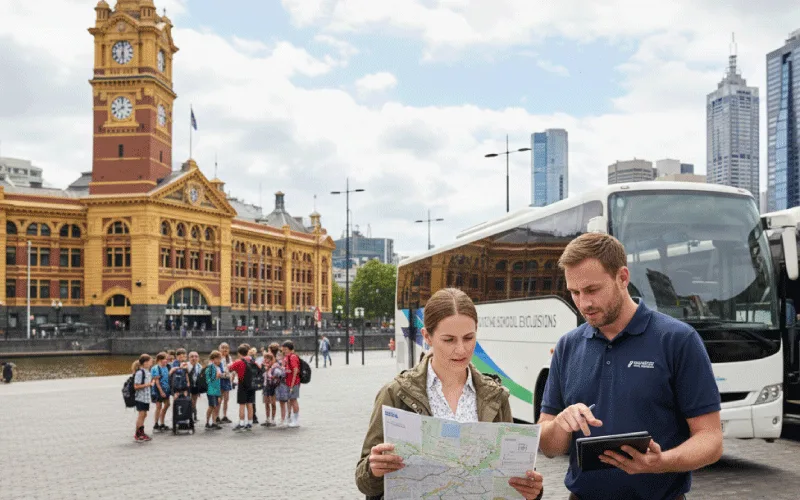Why End-of-Year Excursions Deserve Extra Care
The end of the school year is a special time — students look forward to reward trips, camps, theatre visits, or nature retreats. But weather, daylight hours, exam schedules, and staff availability all create real challenges.
That’s why planning early, comprehensively, and safely is essential. With the right approach, you can deliver a memorable, enriching excursion without undue stress or risk.
In this guide, we’ll walk you through each step — from choosing the right coach to coordinating parent communication — to ensure your end-of-year trips succeed.
1. Establish Clear Educational & Logistical Objectives
a. Define the Purpose
Is the trip for science, history, performing arts, reward, or outdoor education? Align with curriculum outcomes to make it justifiable and meaningful.
b. Choose the Target Grade(s)
Will it be for one class, a whole year level, or multiple classes? That affects size, coach requirements, supervision, and route planning.
c. Establish Budget and Cost Limits
Include transport, admissions, meals, staff costs, contingency, and insurance. Be realistic — last-minute loading often blows budgets.
d. Tentative Timing & Duration
Decide whether it’s a day trip, overnight, or multi-day. For day trips, allow for travel time, rest stops, and margins for delays.
2. Book Coaches Early and Match to Needs
a. Contact Coach Providers in Advance
By mid to late Term 3 or early Term 4, begin seeking quotes. End-of-year demand is high.
b. Choose the Right Vehicle
- Minibus / midi coaches: for smaller groups
- Full coaches: for large cohorts
Accessible coaches: if there are students with mobility needs
Ensure features: seat belts, air conditioning, reliable heating, luggage storage.
c. Confirm Licensing, Insurance & Driver Credentials
Verify the operator holds a valid interstate/state transport license, public liability insurance, and that drivers are trained and cleared for student transport.
d. Request Route Proposals
A credible coach provider should propose efficient routes, travel time estimates, rest/time buffers, and alternate plan options.

3. Risk Assessment & Safety Planning (Mandatory)
Planning an excursion must include a robust risk management process. In Victoria, the Excursions policy mandates careful planning, staff supervision, and documentation. Department of Education, Victoria
a. Site Visit & Information Gathering
Visit the destination in advance (if possible) to assess terrain, access, facilities, hazards (slippery paths, water, wildlife).
b. Identify All Hazards
Consider transport hazards, weather, medical emergencies, separation risk, student behaviour issues, and venue-specific hazards (e.g. water, heights).
c. Implement Risk Controls
Examples: strict supervision ratios, first aid kits, emergency communication, alternative routes, buddy systems, contingency plans.
d. Supervision Ratios & Staffing
Ensure you meet recommended staff ratios. For example, in Victoria, day excursions require at least 1 staff per 20 students and a minimum of 2 staff overall. Department of Education, Victoria
Always plan for replacement staff or absences.
e. Emergency & Incident Plan
Include evacuation plans, contact list, nearest hospitals or medical assistance, backup transport, and communication strategy.
4. Parent Consent, Health & Communication
Planning an excursion must include a robust risk management process. In Victoria, the Excursions policy mandates careful planning, staff supervision, and documentation. Department of Education, Victoria
a. Consent Forms
Send clear permission forms including trip details, medical information, mobility needs, emergency contacts, and disclaimers.
b. Pre-Excursion Briefing
Hold sessions with students and teachers to explain itinerary, behaviour expectations, safety rules, and what to bring.
c. Distribute Itinerary & Contact Information
Share details with parents: pickup/drop-off times, coach contact, staff in charge, contingency timings.
d. Medical & Special Needs Planning
Collect health data in advance. Assign staff to handle students with asthma, allergies, medications, or disabilities.
5. Logistics & Timing
Planning an excursion must include a robust risk management process. In Victoria, the Excursions policy mandates careful planning, staff supervision, and documentation. Department of Education, Victoria
a. Route Selection & Buffers
Avoid overly ambitious itineraries. Incorporate buffer time for traffic delays. Use coach provider’s route modelling.
b. Rest & Meal Breaks
Plan for predictable breaks, snack or lunch stops, bathroom stops. Account for students’ needs, not just transport.
d. Supervision Throughout
Maintain supervision when embarking/disembarking, during stops, and throughout walking segments.
6. Special Conditions for End-of-Year Timing
Planning an excursion must include a robust risk management process. In Victoria, the Excursions policy mandates careful planning, staff supervision, and documentation. Department of Education, Victoria
a. Weather & Daylight
Be aware of early sunsets and variable weather in December-January. Prefer sheltered or indoor components.
b. Exam & Term Timings
Avoid clashes with end-of-year exams. Secure dates early so transport doesn’t conflict with academic priorities.
c. Staffing & Volunteer Availability
Teachers may be less available late in year. Secure staff and volunteer commitment early and confirm backup.
7. Post-Excursion Follow-up & Review
Planning an excursion must include a robust risk management process. In Victoria, the Excursions policy mandates careful planning, staff supervision, and documentation. Department of Education, Victoria
a. Incident Reports & Debriefs
Record any incidents, near misses or feedback. Debrief staff and students to capture lessons.
b. Feedback Surveys
Obtain feedback from teachers, students, parents — on transport, safety, comfort, timing.
c. Reporting & Record Keeping
Retain all planning documents, risk assessments, consent forms, invoices, and incident records (as required by department guidelines). education.nt.gov.au+2education.sa.gov.au+2
d. Continuous Improvement
Use feedback to refine future plans, route choices, staffing models, and risk mitigation.
FAQs: School Excursion Planning Tips
How early should the excursion planning begin?
Start as early as possible — ideally mid Term 3 for end-of-year trips — to ensure best coach availability and risk mitigation.
What supervision ratio should we use?
For day trips, a minimum 1:20 staff-to-student ratio (with at least 2 staff) is common — but adjust upward for risks or younger students.
What if weather or disruptions occur?
Have a contingency plan — alternate routes or destinations, buffer times, or “plan B” indoor options.
How do we handle students with special medical needs?
Collect medical forms early, assign responsible staff, carry first aid equipment, and brief all staff on protocols.
Can we reduce cost on transport?
Yes — book early, negotiate multi-trip or off-peak discounts, combine with other schools, or optimise routes for minimal wasted mileage.
Do we need to conduct site assessments?
Yes — site visits help identify hazards, walking access, emergency access, and suitability of facilities.
Make End-of-Year Excursions A Success
End-of-year school excursions should be celebrations of learning, community, and fun — not stress or safety risks. With structured planning, early bookings, rigorous risk assessments, clear communication, and the right transport partner, your school can deliver unforgettable, safe trips.
Ready to plan your next excursion in Melbourne or Victoria?
Contact Melbourne Coach Hire for a quote and route planning assistance
Let us help you make the journey as rewarding as the destination.
